10 Best WiFi Temperature Monitors
I’ve tested multiple WiFi temperature monitors this year, and the Govee H5103 stands out with its Swiss-made sensor delivering ±0.54°F accuracy and 6-month battery life. For multi-room monitoring, the GoveeLife 2.0 three-pack offers excellent value with 2-second updates and 20-day data storage. The H5179 provides the fastest refresh rates for critical applications. All models require 2.4GHz WiFi and offer smartphone alerts when temperatures exceed your set thresholds. Below, I’ll break down each monitor’s specific strengths and ideal use cases.
We are supported by our audience. When you purchase through links on our site, we may earn an affiliate commission, at no extra cost for you. Learn more. Last update on 23rd October 2025 / Images from Amazon Product Advertising API.
Notable Insights
- Swiss-made sensors in Govee models deliver professional-grade accuracy with ±0.54°F temperature and ±3%RH humidity precision for reliable monitoring.
- Most WiFi temperature monitors require 2.4GHz networks and offer real-time updates every 2 seconds with smartphone app connectivity.
- Data storage capabilities range from 13-day to 2-year historical tracking with export functionality for long-term climate analysis.
- Smart home integration includes Alexa and Google Home compatibility, plus customizable alerts via app, email, and audible notifications.
- Multi-sensor systems support up to 10 devices per network with 230ft range, ideal for whole-home monitoring solutions.
Govee WiFi Thermometer Hygrometer H5103, Indoor Bluetooth Temperature Humidity Sensor
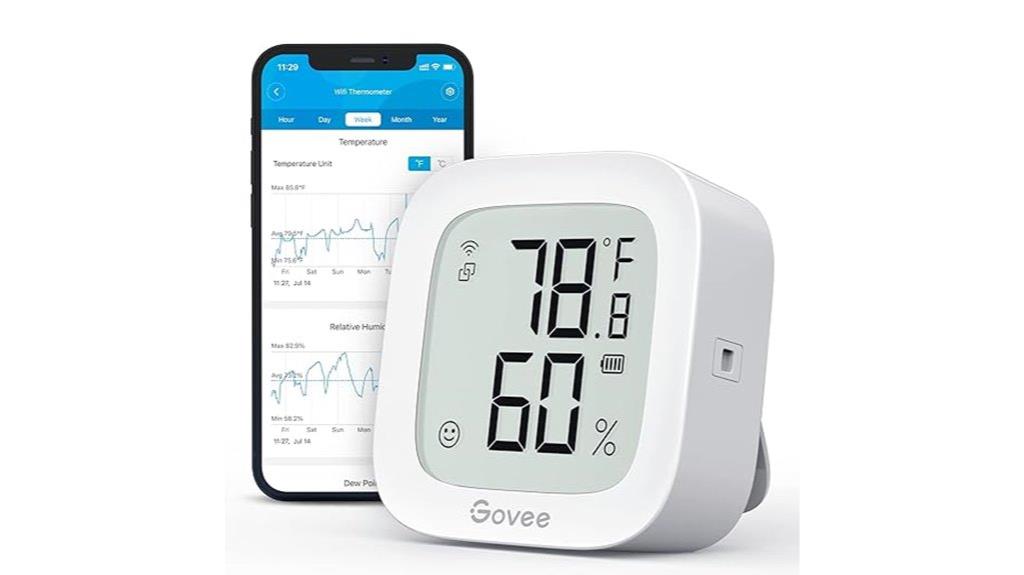
The Govee WiFi Thermometer Hygrometer H5103 stands out as an excellent choice for homeowners who need to keep tabs on temperature and humidity levels across multiple rooms or hard-to-reach spaces. You’ll get precise readings with ±0.54°F temperature accuracy and ±3%RH humidity accuracy thanks to its Swiss-made sensor. The device connects to your 2.4GHz WiFi network and pairs with the Govee Home App for real-time monitoring from anywhere. You can view 13-day data graphs online and export up to two years of historical data. The electronic ink display offers excellent readability while providing up to six months of battery life.
Best For: Homeowners who need reliable remote monitoring of temperature and humidity in multiple rooms, basements, wine cellars, or other hard-to-reach spaces with precise data tracking and export capabilities.
Pros:
- Swiss-made sensor delivers highly accurate readings with ±0.54°F temperature and ±3%RH humidity precision
- WiFi connectivity enables real-time remote monitoring through the Govee Home App with 13-day data graphs and 2-year data export
- Electronic ink display provides excellent readability while maintaining impressive 6-month battery life
Cons:
- Display may freeze or become unresponsive over time requiring troubleshooting
- Only supports 2.4GHz WiFi networks, not compatible with 5GHz connections
- Alert notifications can be brief and easily missed when monitoring critical environments
Govee WiFi Thermometer Hygrometer H5179, Smart Humidity Temperature Sensor
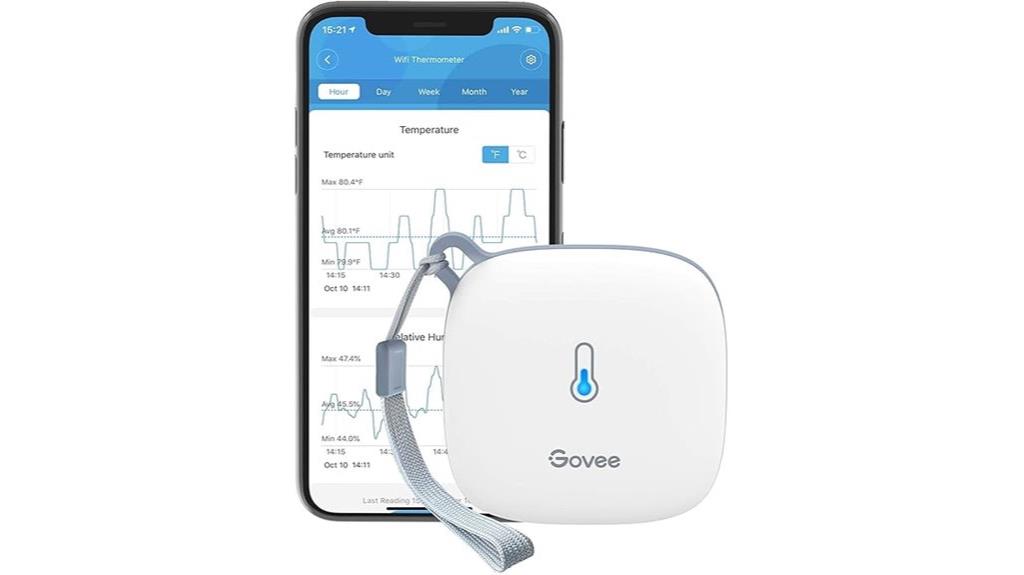
Govee’s WiFi Thermometer Hygrometer H5179 stands out as an excellent choice for homeowners who need precise environmental monitoring without complicated setup procedures. You’ll appreciate the Swiss-made sensor that delivers temperature readings within ±0.54°F and humidity measurements within ±3%RH accuracy. The device refreshes data every two seconds, ensuring you’re always working with current information through the Govee Home app. You can store 20 days of online data and export up to two years of historical records for long-term analysis. The alert function notifies you when conditions exceed your preset ranges, while the included lanyard loop offers flexible placement options throughout your home.
Best For: Homeowners and professionals who need accurate, real-time environmental monitoring with smartphone alerts and long-term data tracking capabilities.
Pros:
- High accuracy Swiss-made sensor with ±0.54°F temperature and ±3%RH humidity precision
- Real-time monitoring with 2-second refresh rate and smartphone alerts for preset range violations
- Extensive data storage with 20 days online and up to 2 years of exportable historical data
Cons:
- Limited to 2.4G Wi-Fi networks only, excluding newer 5G connections
- Requires smartphone app for all functionality, no standalone display or controls
- Online data storage limited to just 20 days compared to the 2-year export capability
GoveeLife 2.0 WiFi Hygrometer Thermometer (3 Pack Smart Humidity Temperature Sensor)
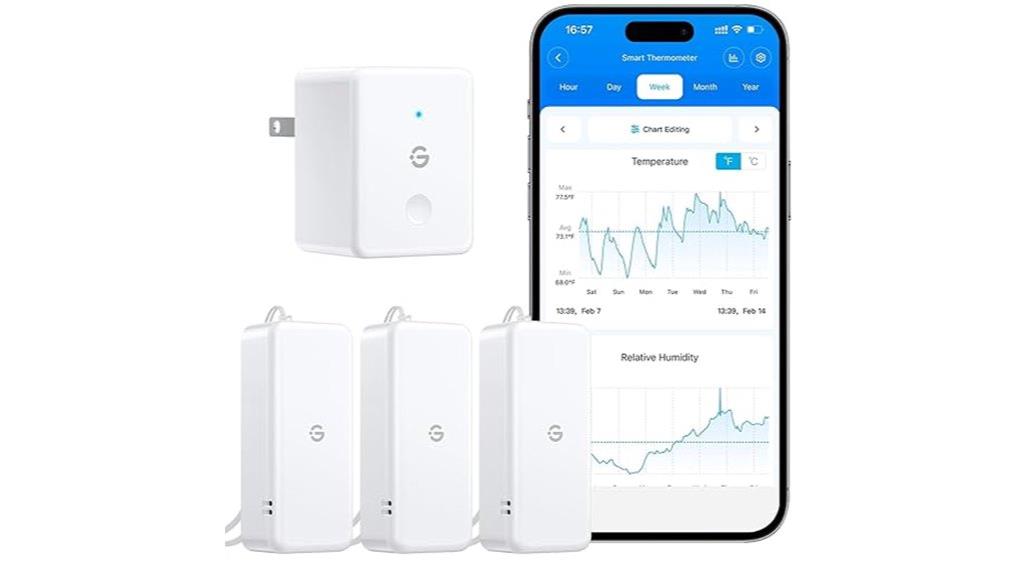
Smart home enthusiasts who want detailed environmental monitoring across multiple rooms will find the GoveeLife 2.0 WiFi Hygrometer Thermometer 3-pack particularly valuable. You’ll get three compact sensors that connect to your 2.4GHz WiFi network and monitor up to 10 total sensors through the Govee Home app. Each sensor delivers precise readings with ±0.54°F temperature accuracy and ±3% humidity accuracy, updating data every two seconds. You can track environmental trends over 20 days and export two years of stored data. The system sends remote alarm notifications when conditions exceed your preset ranges, making it perfect for wine cellars or sensitive areas.
Best For: Smart home enthusiasts who want detailed environmental monitoring across multiple rooms and need precise temperature and humidity tracking with remote alerts and long-term data storage.
Pros:
- High-precision readings with ±0.54°F temperature and ±3% humidity accuracy, updating every 2 seconds
- Comprehensive data management with 2-year free storage, 20-day trend viewing, and data export capabilities
- Easy setup with remote alarm notifications and support for up to 10 sensors on one network
Cons:
- Limited to 2.4GHz WiFi networks only, which may not work with some modern router configurations
- Requires a separate gateway that plugs directly into an outlet, taking up wall space
- Compact design may make the display difficult to read from a distance
WiFi Humidity Temperature Monitor: Smart Hygrometer Thermometer (4-Pack)
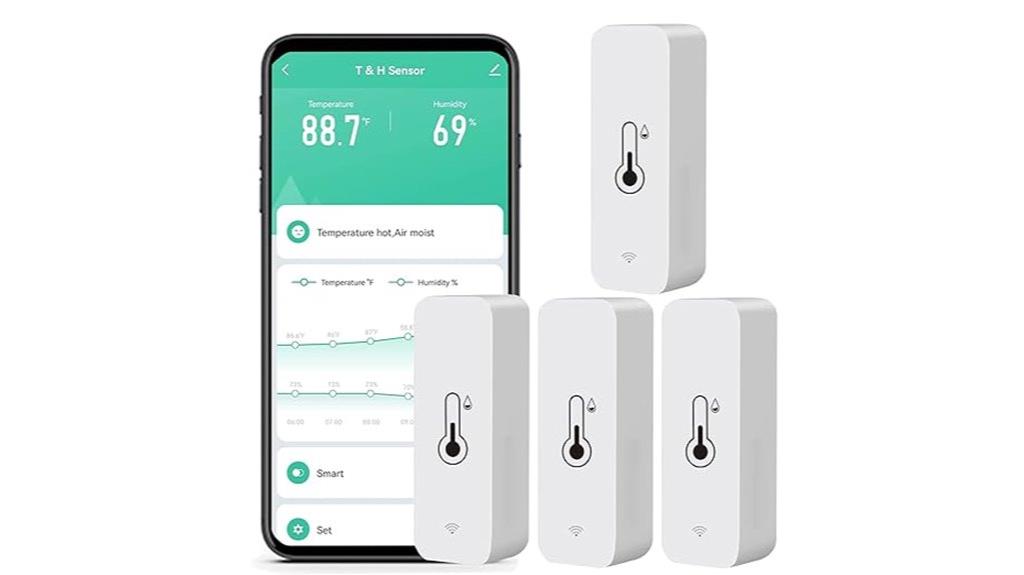
Multi-room monitoring becomes effortless with this 4-pack WiFi humidity temperature monitor system that eliminates the need for additional hubs or complex wiring. You’ll connect directly to your 2.4 GHz WiFi network and control everything through the Tuya/Smart Life app. The compact sensors run on two AAA batteries, delivering 2-4 weeks of operation with standard batteries or about 32 days with rechargeable NiMH batteries. You can mount them on walls, place on tables, or squeeze into tight spaces for versatile installation options. The app updates typically lag 1-2 hours behind real-time conditions, and you’ll notice temperature readings can vary up to 2°F between sensors in identical locations.
Best For: Homeowners who want to monitor temperature and humidity across multiple rooms without complex setup and don’t mind some delays in data updates.
Pros:
- No hub required – connects directly to 2.4 GHz WiFi with easy app setup
- Versatile installation options with compact design for walls, tables, or tight spaces
- Compatible with Alexa and Google Home for voice control and smart home integration
Cons:
- App updates lag 1-2 hours behind real-time conditions
- Temperature readings can vary up to 2°F between sensors in the same location
- Battery life is relatively short at 2-4 weeks with standard batteries
Govee WiFi Hygrometer Thermometer Sensor (3 Pack)
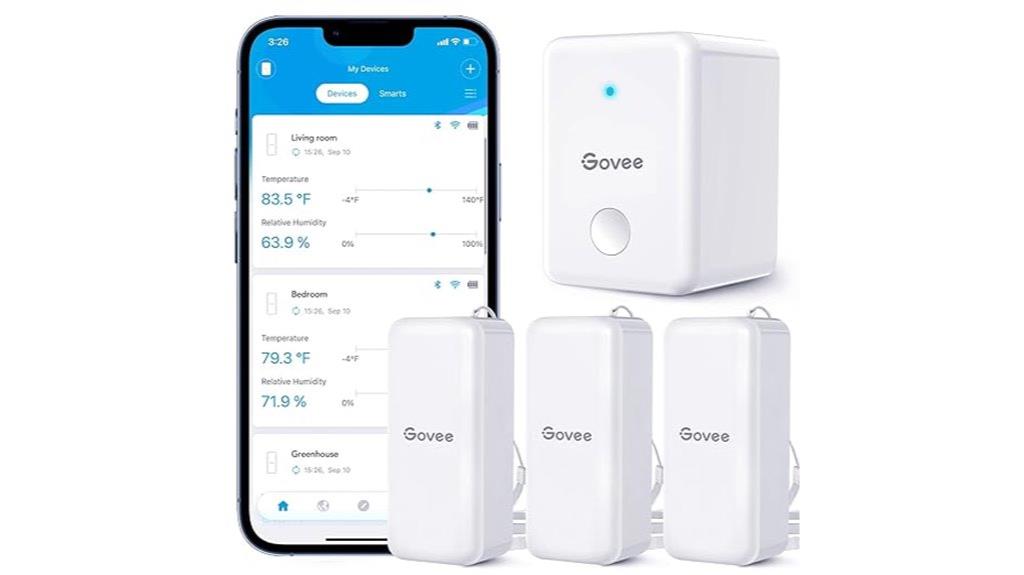
Why settle for guesswork when monitoring multiple rooms requires precise temperature and humidity data? You’ll get Swiss-made sensors that deliver accurate readings within ±0.54°F and measure humidity from 0-99%RH. The system supports up to 10 sensors, connecting through your home WiFi network (not 5G networks). You can set custom temperature and humidity ranges to receive phone alerts when conditions change. The compact design fits tight spaces, and included lanyards let you hang sensors where needed. Data storage includes 20-day graphs and 2-year export capability for long-term tracking. Battery life lasts approximately one year, though you’ll occasionally need to reconnect sensors for ideal performance.
Best For: Homeowners, gardeners, and hobbyists who need to monitor temperature and humidity conditions across multiple rooms or spaces like greenhouses, wine cellars, nurseries, or basements with precise data tracking and smartphone alerts.
Pros:
- Swiss-made sensors provide highly accurate temperature readings (±0.54°F/±0.3°C) and full humidity range (0-99%RH)
- Comprehensive data management with 20-day graphs, 2-year export capability, and customizable phone alerts for temperature and humidity ranges
- Supports up to 10 sensors with compact design and included lanyards for flexible placement options
Cons:
- Only connects to standard home WiFi networks, not compatible with 5G networks
- Requires occasional reconnection of sensors to maintain optimal performance
- Battery replacement needed approximately once per year for each sensor
GHome Smart WiFi Thermometer Hygrometer with App Control

The GHome Smart WiFi Thermometer Hygrometer stands out as an ideal choice for tech-savvy homeowners who want thorough climate monitoring with smart home integration capabilities. You’ll get accurate readings within ±1°C for temperature and ±5%RH for humidity across ranges of 0-60°C and 0-99%RH respectively. The built-in IR remote function lets you control other smart devices directly from the unit. You can store up to one year of data and export it through the mobile app, which supports multiple device connections and customizable recording intervals. However, you’ll need USB power since there’s no battery backup, and the display lacks backlighting for low-light reading.
Best For: Tech-savvy homeowners who want comprehensive climate monitoring with smart home integration and long-term data tracking capabilities.
Pros:
- Built-in IR remote control function allows direct control of other smart home devices
- Stores up to 1 year of data with export functionality and supports multiple device connections on one app
- Accurate sensor readings with ±1°C temperature accuracy and ±5%RH humidity accuracy
Cons:
- No backlit display makes readings difficult in low-light conditions and occasionally resets to Celsius scale
- Requires USB power with no battery backup and only supports 2.4GHz WiFi networks
- Limited temperature range (0-60°C) not suitable for very cold environments and app has minor glitches in data reporting
WiFi Temperature Humidity Sensor with App Alert & Alexa Compatible (1-Pack)
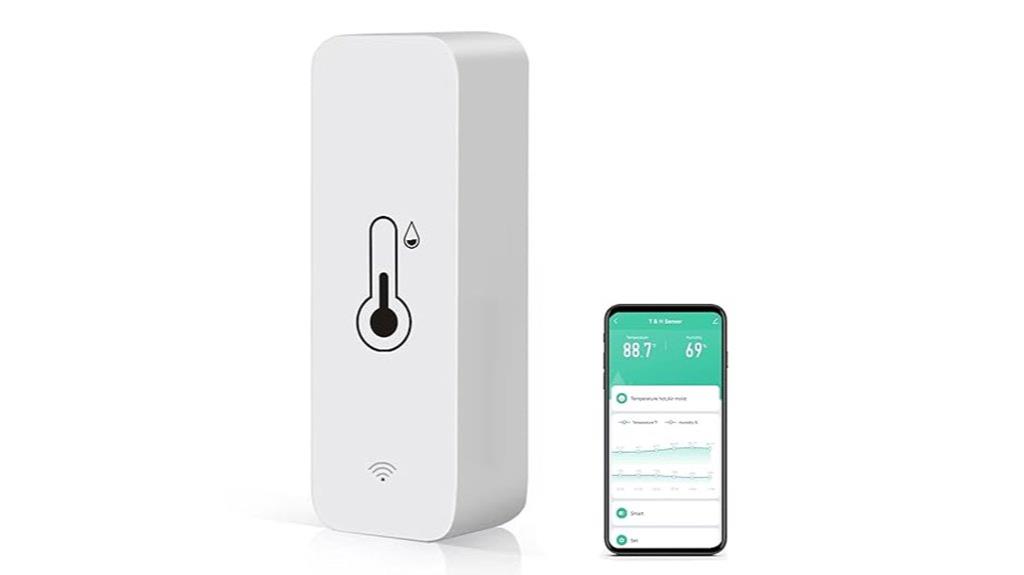
Budget-conscious homeowners who want reliable climate monitoring without breaking the bank will find this WiFi temperature humidity sensor delivers essential smart home features at an affordable price point. You’ll connect directly to your 2.4 GHz WiFi network without needing additional hubs, and the Tuya Smart or Smart Life apps provide remote monitoring with temperature and humidity graphs. The sensor tracks historical data and sends alerts when conditions change beyond your preset thresholds. You can create automated scenes that trigger your AC or dehumidifier based on readings, and voice control works through Amazon Alexa or Google Home. Two AAA batteries power the compact device for extended operation.
Best For: Budget-conscious homeowners who want reliable climate monitoring without breaking the bank will find this WiFi temperature humidity sensor delivers essential smart home features at an affordable price point.
Pros:
- No hub required – connects directly to 2.4 GHz WiFi for simple setup
- Smart automation capabilities with scene creation to trigger AC or dehumidifier based on readings
- Voice control compatibility with Amazon Alexa and Google Home for hands-free operation
Cons:
- Requires 2xAAA batteries which will need periodic replacement
- Limited to 2.4 GHz WiFi networks only, not compatible with 5 GHz bands
- Compact design may limit display size and readability compared to larger sensors
GoveeLife WiFi Refrigerator Thermometer with Alarm (2 Pack)
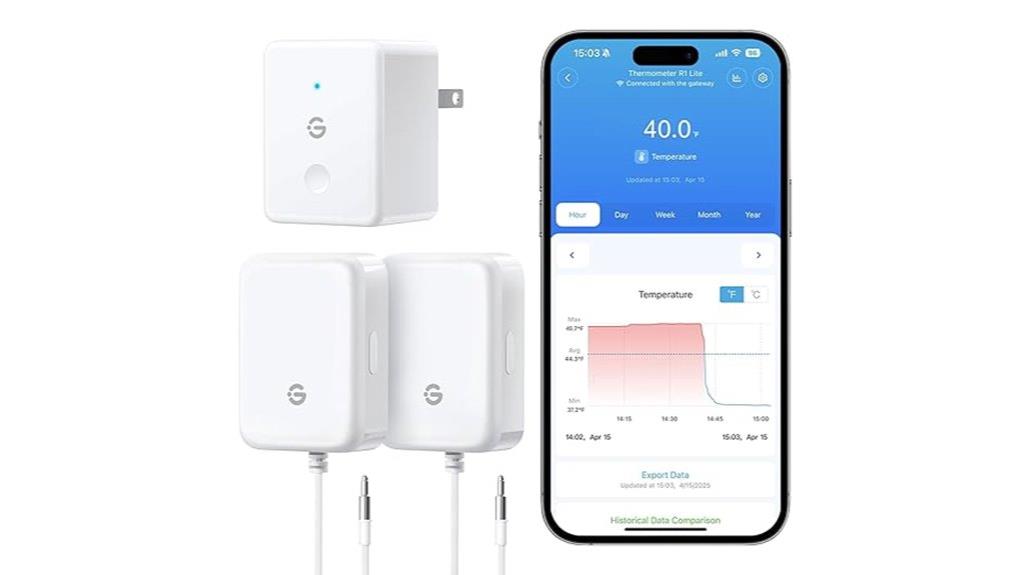
Serious food safety enthusiasts will appreciate the GoveeLife WiFi Refrigerator Thermometer‘s thorough alert system that prevents costly spoilage through multiple notification methods. You’ll receive app notifications, email alerts, and an 80dB buzzer alarm whenever temperatures drift outside your preset ranges. The ultra-sensitive 2.7mm NTC probe delivers ±0.9°F precision with lightning-fast 2-second response times, monitoring temperatures from -40°F to 158°F. Installation takes just five minutes using the magnetic or hanging design. One gateway supports up to ten sensors within 230 feet, perfect for monitoring multiple appliances. You can track temperature cycles and export historical data to identify patterns.
Best For: Food safety enthusiasts and homeowners who want comprehensive refrigerator monitoring with multiple alert methods to prevent spoilage and costly food loss.
Pros:
- Triple alert system (app, email, 80dB buzzer) ensures you never miss temperature problems
- Highly accurate ±0.9°F precision with ultra-fast 2-second response time for reliable monitoring
- One gateway supports up to 10 sensors within 230ft range, allowing monitoring of multiple appliances
Cons:
- Requires WiFi connection which may be unreliable in some locations like garages or basements
- 80dB alarm could be disruptive in quiet environments or at night
- Limited to monitoring temperature only, doesn’t track other factors like humidity or door status
GoveeLife Smart Hygrometer Thermometer (H5179)
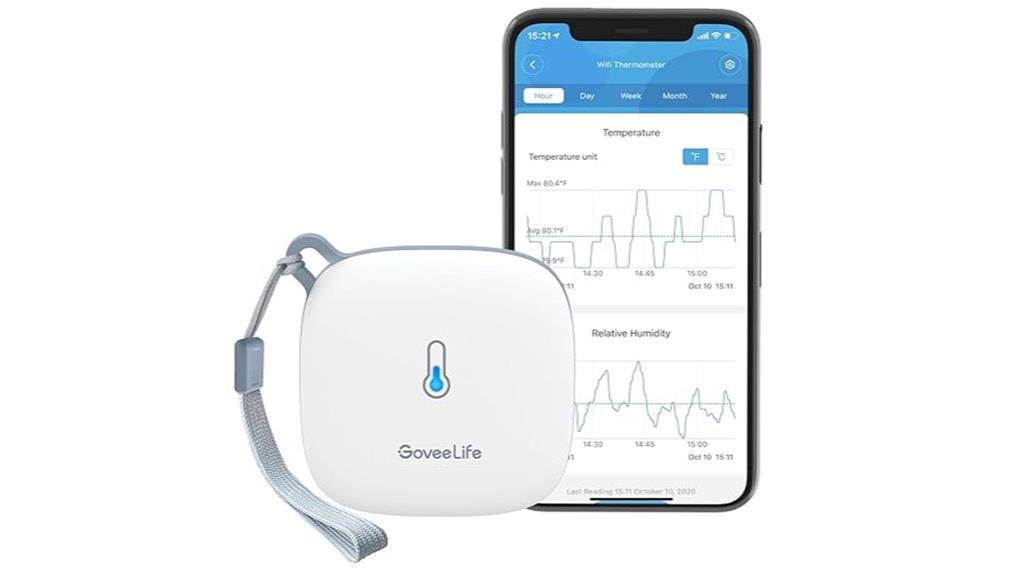
Smart home enthusiasts who demand precise environmental monitoring will find the GoveeLife Smart Hygrometer Thermometer (H5179) delivers professional-grade accuracy through its Swiss-made sensor technology. You’ll get temperature readings within ±0.54°F and humidity measurements within ±3%RH, with updates every two seconds across a -4°F to 140°F range. The device connects to your WiFi network for remote monitoring through smartphone widgets, though it won’t work with 5G networks. You can set custom alert thresholds and receive instant notifications when conditions exceed your preset values. The system stores two years of historical data with convenient daily, weekly, and monthly filtering options for trend analysis.
Best For: Smart home enthusiasts and professionals who need precise, continuous environmental monitoring with remote access and long-term data tracking capabilities.
Pros:
- Swiss-made sensor delivers professional-grade accuracy with ±0.54°F temperature and ±3%RH humidity precision
- Comprehensive data management with 2 years of storage, multiple filtering options, and real-time monitoring every 2 seconds
- Convenient remote monitoring via WiFi with smartphone widgets and instant alert notifications when thresholds are exceeded
Cons:
- Not compatible with 5G WiFi networks, limiting connectivity options in some modern setups
- Data visualization is limited to 20-day graphs despite storing 2 years of data
- Small portable design may make it easy to misplace without proper mounting or securing
WiFi Thermometer Freezer Alarm with 2 Remote Wireless Temperature Sensors
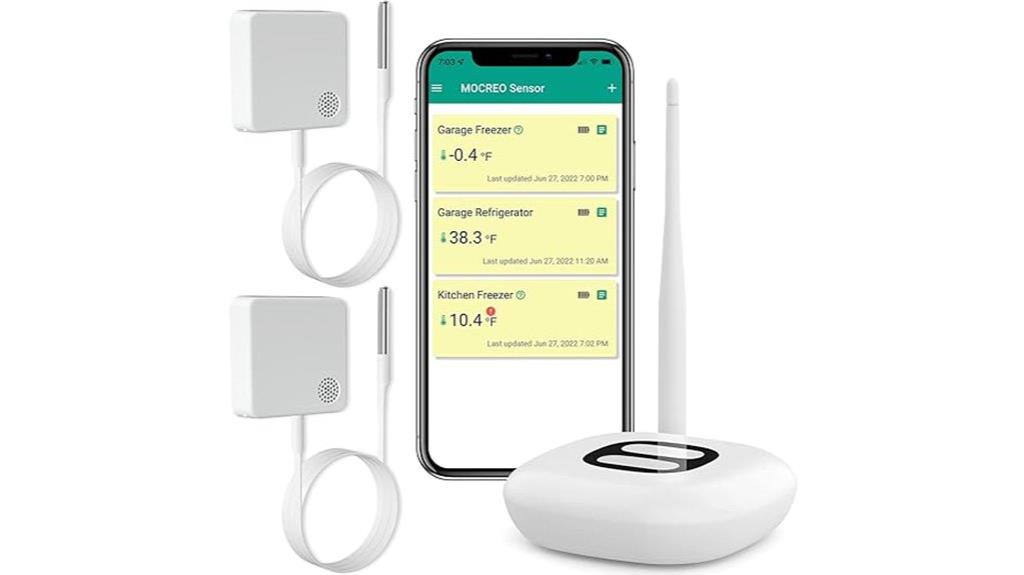
Two wireless sensors make this WiFi thermometer freezer alarm perfect for homeowners who need to monitor multiple temperature-sensitive areas simultaneously. You’ll receive alerts through email, app notifications, or an 80dB audible alarm when temperatures fall outside your preset range. The system tracks temperatures from -40°F to 257°F with ±0.9°F accuracy using industrial-grade chips. You can export two years of data without paying subscription fees, and the sensors’ batteries last up to two years. Setup connects easily through 2.4GHz WiFi networks, making installation straightforward for monitoring freezers, refrigerators, or other temperature-critical equipment throughout your home.
Best For: Homeowners and businesses who need reliable, long-term monitoring of multiple freezers, refrigerators, or other temperature-sensitive equipment without ongoing subscription costs.
Pros:
- Two wireless sensors allow simultaneous monitoring of multiple locations with accurate ±0.9°F precision
- Multiple alert options (email, app, 80dB alarm) ensure you’re notified immediately of temperature issues
- No subscription fees required for 2-year data export and up to 2-year battery life reduces ongoing costs
Cons:
- Limited to 2.4GHz WiFi networks only, which may not be compatible with some modern router configurations
- Temperature range stops at 257°F, limiting use for high-temperature industrial applications
- Only includes 2 sensors, requiring additional purchases for monitoring more than 2 locations
Factors to Consider When Choosing WiFi Temperature Monitors
I’ll help you choose the right WiFi temperature monitor by examining five critical factors that directly impact performance and usability. When I evaluate these devices, I focus on sensor accuracy standards (typically ±0.5°F to ±2°F), WiFi connectivity requirements for your home network, and realistic battery life expectations ranging from 6 months to 2 years. You’ll also need to ponder data storage options like cloud services versus local storage, plus alert system features that include email notifications, smartphone apps, and audible alarms.
Sensor Accuracy Standards
When you’re selecting a WiFi temperature monitor for your smart home, sensor accuracy becomes the foundation that determines whether your device provides trustworthy data or misleading readings. I recommend looking for temperature sensors with an accuracy of ±0.5°C or ±0.9°F, which guarantees reliable environmental monitoring throughout your home.
For humidity tracking, you’ll want sensors that maintain ±3% relative humidity accuracy or better. This precision helps you make informed decisions about comfort levels and potential moisture problems. Response time matters too—faster sensors provide real-time updates when conditions change rapidly.
Consider long-term stability and sensor drift characteristics, especially for permanent installations. Professional-grade sensors often meet NIST-traceable standards, giving you consistent and verifiable measurements you can depend on for years.
WiFi Connectivity Requirements
Your WiFi temperature monitor’s connectivity depends entirely on having a stable 2.4GHz wireless network, since these devices don’t support the faster 5GHz bands that many modern routers offer. I recommend checking your router’s 2.4GHz signal strength in areas where you’ll place sensors, as building materials and distance can substantially weaken connectivity.
Interference from other wireless devices, microwaves, and baby monitors can disrupt real-time data transmission. Position your sensors within robust WiFi coverage zones to guarantee consistent monitoring and alerts. Many models include Bluetooth backup connectivity for local monitoring when WiFi fails temporarily.
Before purchasing, verify your router broadcasts 2.4GHz networks and consider upgrading older routers that struggle with multiple connected devices. Strong, consistent connectivity assures reliable temperature data reaches your smartphone instantly.
Battery Life Expectations
Battery life stands as one of the most critical factors when selecting WiFi temperature monitors, since these devices must balance continuous wireless connectivity with extended operation periods. I’ve found that battery duration varies dramatically, ranging from several weeks to over a year depending on your device’s configuration and usage patterns.
Rechargeable NiMH batteries typically outlast alkaline options, though you’ll need to recharge them more frequently. Smart sensors that transmit data only when temperature changes occur markedly extend battery life compared to constant-interval reporting models.
Your monitor’s power consumption depends heavily on transmission frequency, WiFi signal strength, and processor efficiency. Devices with frequent uploads, high-speed connections, and continuous readings drain batteries fastest, while low-power processors and optimized wireless radios maximize operational duration.
Data Storage Options
Most WiFi temperature monitors store your collected data in two distinct ways: cloud-based systems or local device storage. Cloud-based options let you access historical temperature and humidity trends spanning days, weeks, or years through web portals or mobile apps. You’ll find this particularly useful for long-term analysis and remote monitoring. Local storage devices allow you to export data directly without internet dependency, giving you complete control over your information.
Storage capacity varies considerably between models, so I recommend checking each device’s specifications carefully. Some monitors integrate seamlessly with smart home platforms like Alexa or Google Home, enabling voice-activated data requests. Consider your specific monitoring needs, privacy preferences, and reporting requirements when evaluating storage options, as these features directly impact your system’s functionality.
Alert System Features
When temperatures drift beyond safe ranges, effective alert systems become your first line of defense against potential damage to sensitive items. I recommend looking for monitors that offer multiple notification methods, including push notifications, email alerts, and audible alarms. You’ll want customizable alert settings that let you adjust temperature and humidity thresholds for your specific needs. Multi-tier alert systems prove particularly valuable, providing different alarm levels for minor fluctuations versus severe out-of-range conditions. Remote alert capabilities guarantee you’ll receive notifications even when you’re away from home. These timely warnings help you quickly identify issues with food storage, medications, or other temperature-sensitive products before costly damage occurs.
On a final note
I’ve reviewed the top WiFi temperature monitors for 2025, focusing on reliability, accuracy, and smart home integration. These devices help you maintain ideal conditions in your home, freezer, or refrigerator while providing real-time alerts. Choose models with proven connectivity, accurate sensors (±0.5°F), and compatible apps. Consider your specific needs like battery life, range requirements, and alert preferences. Investing in quality monitoring protects your comfort and valuable temperature-sensitive items.
